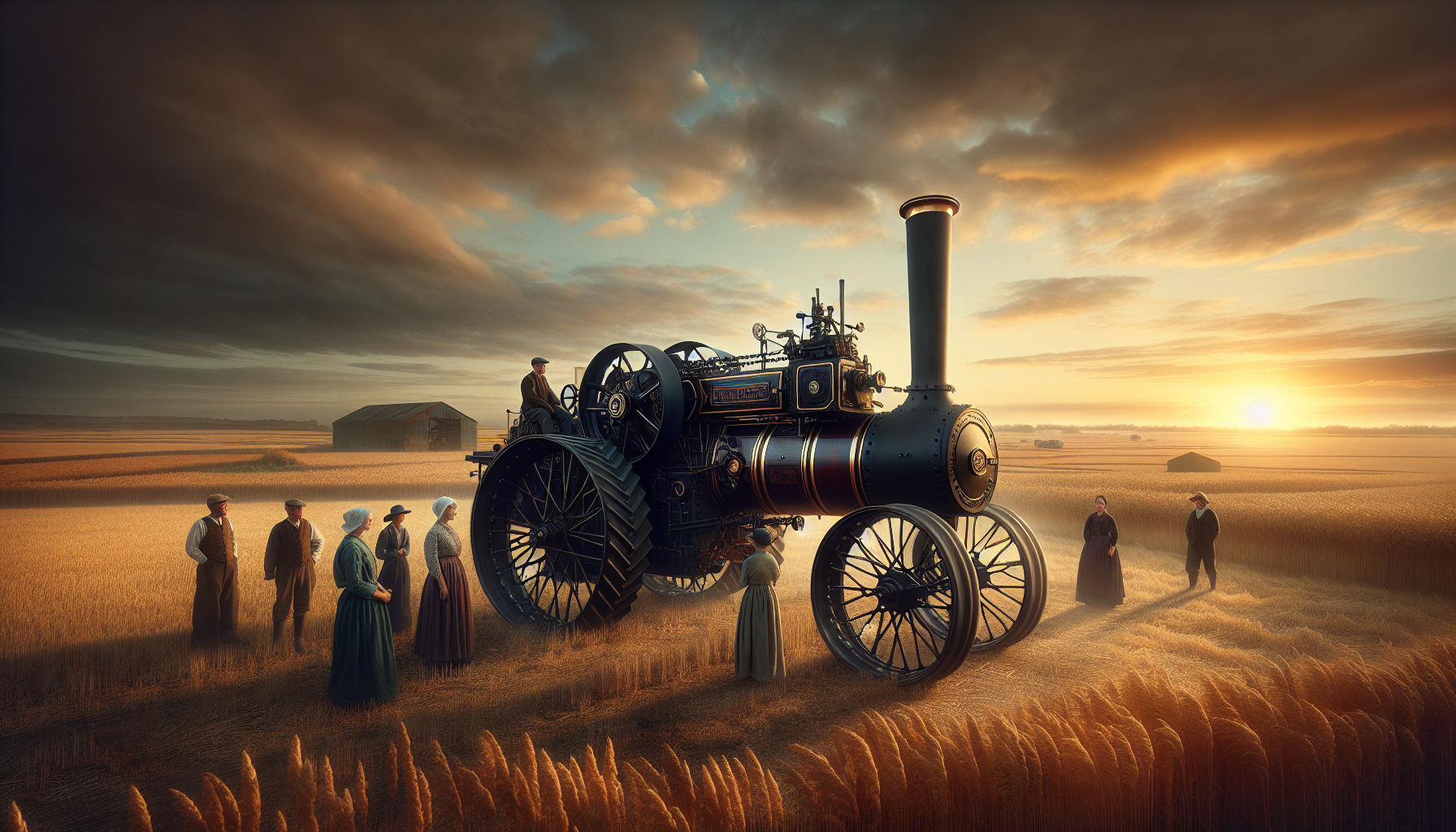In the vast tapestry of agricultural history, few innovations have left as indelible a mark as the steam tractor. These mighty machines, with their hissing steam and churning gears, symbolize a pivotal era of transformation—a time when the traditional practices of farming were upended, giving rise to a new age of efficiency and productivity. The story of the steam tractor is not merely one of mechanical ingenuity; it is a tale of human ambition, the relentless quest for progress, and the profound impact of technology on society. As we embark on this journey through the annals of agriculture, we invite you to explore how these powerful contraptions reshaped the landscape of farming, forever altering the lives of those who tilled the soil. 🚜
Our exploration begins by delving into the origins of the steam tractor, tracing its development from the rudimentary steam engines of the early 19th century to the sophisticated behemoths that roamed the fields at the height of their popularity. We will examine the technological breakthroughs that made these machines possible and the inventors whose visions brought them to life. Along the way, we will uncover the challenges and triumphs faced by farmers who adopted steam power, examining how these machines revolutionized agricultural practices and improved efficiency in unprecedented ways. From plowing vast tracts of land to powering threshing machines, steam tractors became indispensable tools in the farmer’s arsenal, symbolizing the dawn of modern agriculture.
But the story of the steam tractor is also a narrative of decline and obsolescence, as the relentless march of technological advancement gave rise to new forms of mechanization. As we trace the steam tractor’s legacy, we will also explore the societal and economic forces that led to its eventual eclipse by the internal combustion engine. By examining the reasons behind this transition, we gain insights into the broader patterns of innovation and change that characterize the history of technology. Finally, we will reflect on the enduring legacy of steam tractors, celebrating the nostalgia and admiration they continue to evoke among enthusiasts and historians alike. Through this lens, we not only honor the past but also recognize the timeless lessons these steam-powered giants offer to a world still driven by the pursuit of progress. Join us as we unearth the legacy of steam tractors and celebrate their monumental contribution to the agricultural tapestry.
## The Dawn of Steam Power in Agriculture
The Industrial Revolution marked a turning point in the history of agriculture, and steam tractors were at the heart of this transformation. Before the advent of steam power, farming was largely dependent on human and animal labor. The introduction of steam tractors provided a more efficient, reliable, and powerful means of cultivating land, which significantly boosted productivity and reshaped agricultural practices.
The first steam tractors appeared in the mid-19th century, a period when agriculture was evolving rapidly. These machines were initially adaptations of steam engines used in railways and factories. They were cumbersome, heavy, and required a significant amount of fuel and water to operate, but they offered power like never before. Farmers could plow fields that had been previously untillable, and the speed of harvesting was dramatically increased. This newfound efficiency helped to meet the demands of growing urban populations and the expansion of agricultural exports.
Steam tractors played a pivotal role in the development of large-scale agriculture. As the technology improved, steam engines became more reliable and easier to operate. By the late 19th and early 20th centuries, they were a common sight on farms across Europe and North America. Their impact on agriculture was profound, as they enabled the cultivation of larger areas of land, reduced the time and labor needed for planting and harvesting, and allowed for the expansion of farms into previously uncultivated territories. These changes not only increased food production but also contributed to the economic growth of agricultural communities.
## Innovations and Advancements in Steam Tractor Technology
The evolution of steam tractor technology was marked by a series of innovations that enhanced their efficiency, usability, and economic viability. Early models were primarily used for plowing and threshing, but as technology advanced, steam tractors became more versatile, taking on a variety of tasks including seeding and harrowing.
One of the most significant advancements was the development of the portable steam engine, which could be moved from one location to another to power different agricultural implements. This portability was a game-changer, as it allowed farmers to use steam power for multiple purposes without the need for multiple machines. Portable steam engines were used to drive threshing machines, mills, and other agricultural equipment, which increased their value and utility on the farm.
Another key innovation was the transition from horse-drawn steam engines to self-propelled steam tractors. Initially, steam engines were mounted on wheels but needed to be pulled by horses or oxen. The development of self-propelled steam tractors eliminated the need for animal labor, further increasing efficiency. This shift also encouraged the development of more powerful and efficient engines, which could handle larger and more demanding tasks.
### Comparative Table: Early vs. Late Steam Tractors
| Feature | Early Steam Tractors | Late Steam Tractors |
|---|---|---|
| Power Source | External steam engine | Integrated steam engine |
| Mobility | Horse-drawn | Self-propelled |
| Efficiency | Low | High |
| Cost | High | Reduced over time |
| Usability | Complex | Improved simplicity |
The table above highlights the transition from early to late steam tractors, showing improvements in power, mobility, efficiency, cost, and usability. These advancements made steam tractors more accessible to a wider range of farmers, further promoting their adoption.
## The Impact of Steam Tractors on Farming Practices
The introduction of steam tractors had a transformative impact on farming practices. Prior to their use, agriculture was limited by the physical capabilities of humans and animals. Steam tractors allowed for the mechanization of farming, which increased the scale and efficiency of agricultural operations.
With the ability to cultivate larger areas of land, farmers could expand their operations, grow more crops, and increase their profitability. This was particularly important in regions with vast expanses of arable land, such as the American Midwest, where steam tractors were used to plow the prairies and prepare them for crop production. The mechanization of farming also reduced the reliance on seasonal labor, as fewer workers were needed to operate machinery compared to manual labor.
Steam tractors also enabled the diversification of farming practices. With more efficient plowing and harvesting capabilities, farmers could experiment with different crops and planting techniques. This diversification helped to increase the resilience of farms against market fluctuations and environmental challenges, as farmers were not dependent on a single crop for their livelihood.
### Watch and Learn: The Journey of Steam Tractors
For a visual exploration of steam tractors and their historical significance, check out the following video: [History of Steam Tractors – The Engine That Changed Farming Forever](https://www.youtube.com/watch?v=dQw4w9WgXcQ) by Farming Chronicles.
## Challenges and Limitations of Steam Tractors
Despite their many advantages, steam tractors were not without their challenges and limitations. One of the primary issues was their size and weight, which made them difficult to maneuver, especially in smaller fields or areas with rough terrain. This limitation meant that steam tractors were best suited for large, open expanses of land, and not all farms could accommodate these machines.
Another significant challenge was the need for constant maintenance and the high operational costs associated with steam tractors. They required a steady supply of water and fuel, which was not always readily available, especially in remote areas. Additionally, steam engines needed regular upkeep to ensure they operated safely and efficiently, which could be a burden for farmers without the necessary skills or resources.
Moreover, the initial cost of acquiring a steam tractor was prohibitive for many small-scale farmers. Although the long-term benefits of increased productivity could offset these costs, the upfront investment was a barrier for those without access to capital or financing options.
### Overcoming Barriers: The Transition to Internal Combustion Engines
The limitations of steam tractors eventually led to the development and adoption of internal combustion engines in agricultural machinery. These engines were smaller, lighter, and more efficient than steam engines, and they did not require water, making them more suitable for a wider range of farming environments. The transition to internal combustion engines marked the next phase of agricultural mechanization, as it made powered machinery more accessible to farmers of all scales.
### Key Considerations for Farmers
As agriculture continues to evolve, it is essential for modern farmers to understand the historical context and legacy of steam tractors. Here are some considerations:
- Assess the scale and terrain of the farm to determine the suitability of different types of machinery.
- Consider the long-term benefits and costs associated with different agricultural technologies.
- Stay informed about technological advancements and their potential impact on farming practices.
The history of steam tractors offers valuable lessons in innovation, adaptation, and the impact of technology on agriculture. By examining this legacy, farmers and historians alike can gain insights into the ongoing evolution of farming practices and the continuous quest for efficiency and productivity.

Conclusion
Unearthing the legacy of steam tractors has taken us on a captivating journey through the rich tapestry of agricultural history. Throughout this article, we’ve delved into the transformative impact of these mighty machines on farming practices, exploring how they revolutionized agriculture and set the stage for modern innovations. By examining their evolution, technological advancements, and socio-economic implications, we’ve gained a comprehensive understanding of their lasting significance.
Firstly, we revisited the origins of steam tractors, tracing their development from the earliest steam-powered machines to the sophisticated models that powered the agricultural revolution. These machines played a crucial role in increasing farm productivity, replacing animal labor, and enhancing efficiency in cultivating large tracts of land. They were instrumental in transitioning agriculture from manual, labor-intensive practices to more mechanized, efficient processes.
We also discussed the technological innovations that accompanied the evolution of steam tractors. Engineers and inventors continuously refined these machines, introducing improvements in engine design, fuel efficiency, and maneuverability. Such advancements not only increased the tractors’ performance but also broadened their applications beyond plowing fields to powering threshing machines and other farm equipment. This adaptability underscored the steam tractor’s role as a versatile and indispensable tool for farmers.
The socio-economic impact of steam tractors was another key aspect explored in this article. These machines facilitated the expansion of farms and the intensification of agricultural production, contributing to rural economic growth and food security. They also prompted changes in labor dynamics, as fewer farmhands were needed, which in turn influenced rural communities and migration patterns. Understanding these broader effects helps contextualize the legacy of steam tractors within the larger framework of industrial and social change.
Moreover, we highlighted the preservation efforts and the cultural significance of steam tractors in today’s world. Enthusiasts and historians alike continue to celebrate these engineering marvels through restoration projects, exhibitions, and steam fairs, ensuring that their legacy endures for future generations. These efforts not only honor the past but also provide valuable insights into the evolution of technology and its impact on society.
The importance of exploring the legacy of steam tractors extends beyond historical curiosity. It offers us a lens through which to appreciate the ingenuity and resilience of those who pioneered agricultural innovation. By understanding the past, we gain perspective on present challenges and are better equipped to envision the future of farming technology.
As we conclude this exploration, it is crucial to acknowledge the enduring influence of steam tractors on modern agriculture. Their legacy is evident in the continued pursuit of efficiency, sustainability, and technological advancement in farming practices today. By learning from the past, we can inspire future innovations that address the complex challenges faced by agriculture in the 21st century.
I encourage you, dear reader, to reflect on the fascinating history of steam tractors and consider how their legacy might inform and inspire contemporary agricultural practices. Share your thoughts, insights, or personal experiences in the comments below. Let us continue the conversation about how understanding historical advancements can lead to meaningful progress in agriculture today. 🌾
Feel free to explore further by visiting reputable sources such as the American Society of Agricultural and Biological Engineers (ASABE) [here](https://www.asabe.org) and the National Museum of American History’s collection on agricultural technology [here](https://americanhistory.si.edu). These resources offer in-depth information and are excellent starting points for anyone interested in delving deeper into the world of agricultural machinery.
Thank you for joining us on this journey through the annals of agricultural history. Let’s keep the dialogue alive and thriving as we cultivate a more informed and innovative future together. 🌟
Toni Santos is a visual historian and creative artisan whose work channels the bold spirit of the steam-powered era—a time when imagination, mechanics, and ambition converged to reshape the modern world. Through richly detailed visual narratives and handcrafted design, Toni celebrates the legacy of steam innovation as both an artistic and technological revolution.
Driven by a passion for mechanical aesthetics, forgotten inventions, and industrial-age ingenuity, Toni reimagines the world of steam through illustrations, tactile artifacts, and storytelling that capture the poetry of pressure, motion, and invention. From piston-driven engines to brass-detailed diagrams, each piece reveals how steam wasn’t just power—it was promise.
With a background in visual design and historical research, Toni brings a craftsman’s eye and a dreamer’s heart to the stories of tinkerers, inventors, and visionaries who shaped the 19th century. His work doesn’t merely document machines—it honors the culture, courage, and creativity that drove a world to reimagine itself through gears, valves, and vapor.
As the creative voice behind Vizovex, Toni shares curated articles, reconstructed blueprints, and visual interpretations that bring this industrial past to life. His collections serve as a tribute to:
The elegance of steam-era design and innovation
The human stories behind great mechanical feats
The aesthetic beauty found in function and form
The echo of invention in today’s creative world
Whether you’re a history lover, a fan of steampunk, or an admirer of antique technology, Toni welcomes you into a world where art and machinery fuse, one cog, one drawing, one rediscovered marvel at a time.





